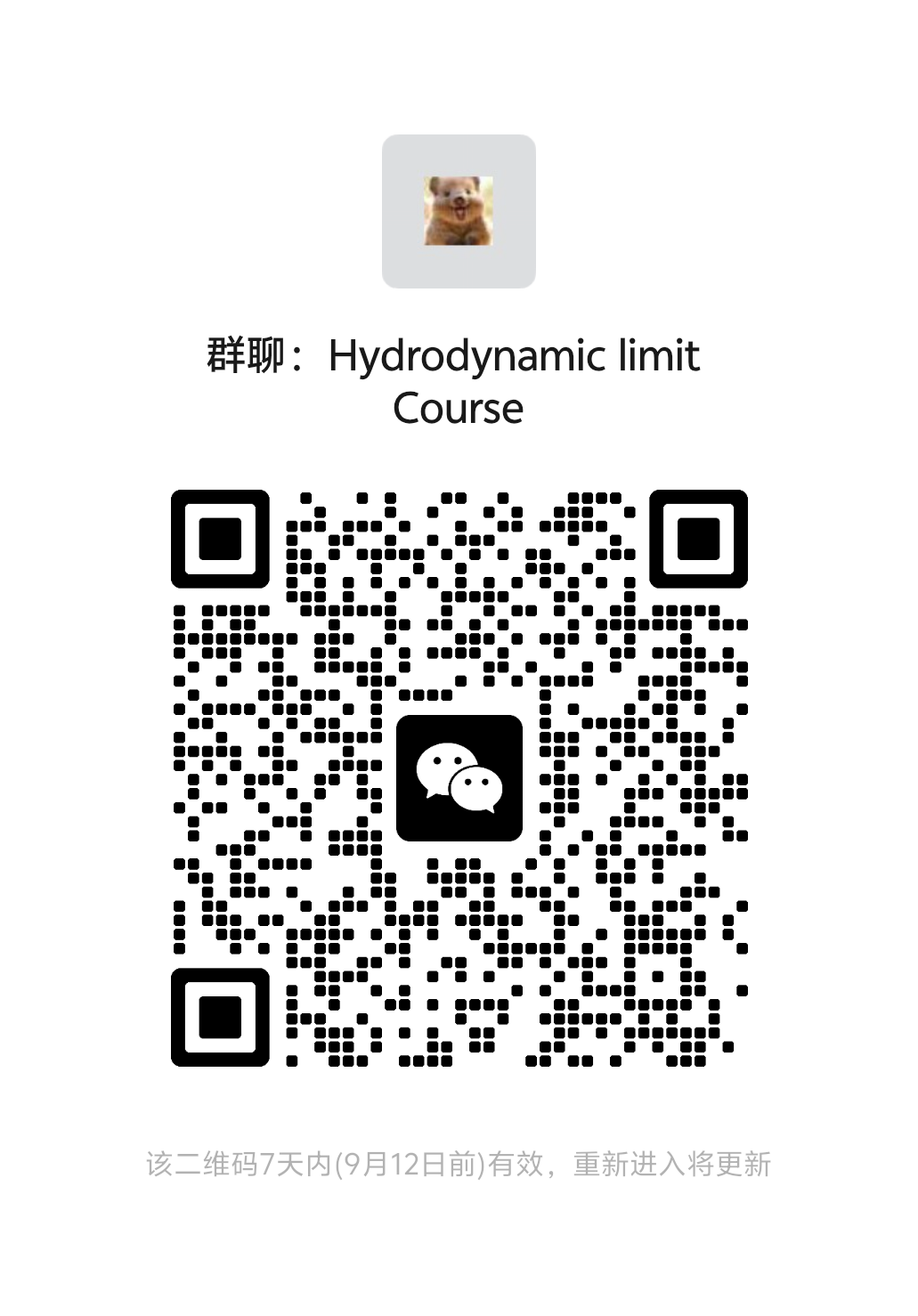Hydrodynamic limit from stochastic interacting systems
We will discuss the derivation of nonlinear PDEs (partial differential equations) from microscopic stochastic interacting systems. This procedure is symbolically called the hydrodynamic limit because it goes through local equilibrium states, with the averaging effect due to local ergodicity playing an essential role. We will also consider fluctuations and discuss the derivation of stochastic PDEs.

Lecturer
Date
15th September ~ 22nd December, 2025
Location
| Weekday | Time | Venue | Online | ID | Password |
|---|---|---|---|---|---|
| Monday,Wednesday | 09:50 - 11:25 | A3-2-301 | ZOOM 05 | 293 812 9202 | BIMSA |
Prerequisite
It is desirable that the audience is familiar with some tools in stochastic analysis such as martingales and stochastic differential equations, cf. [1], [2].
Syllabus
The course consists of the following three parts.
(1) Interacting particle systems, cf. [3], [4], [5]
Exclusion process (Kawasaki dynamics), Zero-range process, Glauber dynamics, Basic facts and tools.
(2) Hydrodynamic scaling limit and fluctuation limit, cf. [3], [6], [7], [12]
Background, Short history of the hydrodynamic limit, Independent random walks as warm-up, Entropy method (Varadhan), One block estimate, Two blocks estimate, Equilibrium fluctuation, Boltzmann-Gibbs principle, Relative entropy method (H.T. Yau), Large deviation, Non-gradient model, Method from quantitative homogenization, Concentration inequality.
(3) Applications and extensions of these methods, cf. [8]-[15]
Derivation of curvature flow for interfaces in phase separation phenomena, Fluctuation of interfaces, Fluctuating hydrodynamics, Coupled KPZ equation.
(1) Interacting particle systems, cf. [3], [4], [5]
Exclusion process (Kawasaki dynamics), Zero-range process, Glauber dynamics, Basic facts and tools.
(2) Hydrodynamic scaling limit and fluctuation limit, cf. [3], [6], [7], [12]
Background, Short history of the hydrodynamic limit, Independent random walks as warm-up, Entropy method (Varadhan), One block estimate, Two blocks estimate, Equilibrium fluctuation, Boltzmann-Gibbs principle, Relative entropy method (H.T. Yau), Large deviation, Non-gradient model, Method from quantitative homogenization, Concentration inequality.
(3) Applications and extensions of these methods, cf. [8]-[15]
Derivation of curvature flow for interfaces in phase separation phenomena, Fluctuation of interfaces, Fluctuating hydrodynamics, Coupled KPZ equation.
Reference
[1] J-F. Le Gall, Brownian motion, martingales, and stochastic calculus, Springer, 2013.
[2] I. Karatzas and S.E. Shreve, Brownian motion and stochastic calculus, Springer, 1991.
[3] C. Kipnis and C. Landim, Scaling limits of interacting particle systems, Springer, 1999.
[4] T.M. Liggett, Interacting particle systems, Springer, 1985.
[5] T.M. Liggett, Stochastic interacting systems: contact, voter and exclusion processes, Springer, 1999.
[6] T. Funaki, Hydrodynamic limit for exclusion processes, Commun. Math. Stat., 6 (2018), 417-480.
[7] T. Funaki, Hydrodynamic limit and stochastic PDEs related to interface motion, ICM2022 Proceedings, EMS Press.
[8] T. Funaki, P. van Meurs, S. Sethuraman and K. Tsunoda, Motion by mean curvature from Glauber-Kawasaki dynamics with speed change, J. Statis. Phys., 190 (2023), Article no. 45, 1-30.
[9] T. Funaki, P. van Meurs, S. Sethuraman and K. Tsunoda, Constant-speed interface flow from unbalanced Glauber-Kawasaki dynamics, Ensaios Matematicos, 38 (2023), 223-248.
[10] C. Bernardin, T. Funaki and S. Sethuraman, Derivation of coupled KPZ-Burgers equation from multi-species zero-range processes, Ann. Appl. Probab., 31 (2021), 1966-2017.
[11] T. Funaki, Interface motion from Glauber-Kawasaki dynamics of non-gradient type, arXiv:2404.18364v2
[12] T. Funaki, C. Gu and H. Wang, Quantitative homogenization and hydrodynamic limit of non-gradient exclusion process, arXiv:2404.12234
[13] T. Funaki and H. Park, Motion of sharp interface of Allen-Cahn equation with anisotropic nonlinear diffusion, arXiv:2403.01732
[14] T. Funaki, C. Landim and S. Sethuraman, Linear fluctuation of interfaces in Glauber-Kawasaki dynamics, arXiv:2412.04015
[15] T. Funaki, Stochastic PDE approach to fluctuating interfaces, arXiv:2412.00708
[2] I. Karatzas and S.E. Shreve, Brownian motion and stochastic calculus, Springer, 1991.
[3] C. Kipnis and C. Landim, Scaling limits of interacting particle systems, Springer, 1999.
[4] T.M. Liggett, Interacting particle systems, Springer, 1985.
[5] T.M. Liggett, Stochastic interacting systems: contact, voter and exclusion processes, Springer, 1999.
[6] T. Funaki, Hydrodynamic limit for exclusion processes, Commun. Math. Stat., 6 (2018), 417-480.
[7] T. Funaki, Hydrodynamic limit and stochastic PDEs related to interface motion, ICM2022 Proceedings, EMS Press.
[8] T. Funaki, P. van Meurs, S. Sethuraman and K. Tsunoda, Motion by mean curvature from Glauber-Kawasaki dynamics with speed change, J. Statis. Phys., 190 (2023), Article no. 45, 1-30.
[9] T. Funaki, P. van Meurs, S. Sethuraman and K. Tsunoda, Constant-speed interface flow from unbalanced Glauber-Kawasaki dynamics, Ensaios Matematicos, 38 (2023), 223-248.
[10] C. Bernardin, T. Funaki and S. Sethuraman, Derivation of coupled KPZ-Burgers equation from multi-species zero-range processes, Ann. Appl. Probab., 31 (2021), 1966-2017.
[11] T. Funaki, Interface motion from Glauber-Kawasaki dynamics of non-gradient type, arXiv:2404.18364v2
[12] T. Funaki, C. Gu and H. Wang, Quantitative homogenization and hydrodynamic limit of non-gradient exclusion process, arXiv:2404.12234
[13] T. Funaki and H. Park, Motion of sharp interface of Allen-Cahn equation with anisotropic nonlinear diffusion, arXiv:2403.01732
[14] T. Funaki, C. Landim and S. Sethuraman, Linear fluctuation of interfaces in Glauber-Kawasaki dynamics, arXiv:2412.04015
[15] T. Funaki, Stochastic PDE approach to fluctuating interfaces, arXiv:2412.00708
Audience
Advanced Undergraduate
, Graduate
, Postdoc
, Researcher
Video Public
Yes
Notes Public
No
Language
English
Lecturer Intro
Funaki Tadahisa was a professor at University of Tokyo (1995-2017) and at Waseda University (2017-2022) in Japan. His research subject is probability theory mostly related to statistical physics, specifically interacting systems and stochastic PDEs. He was a president of Mathematical Society of Japan (2013-2015), and was an invited sectional lecturer at ICM 2022.




